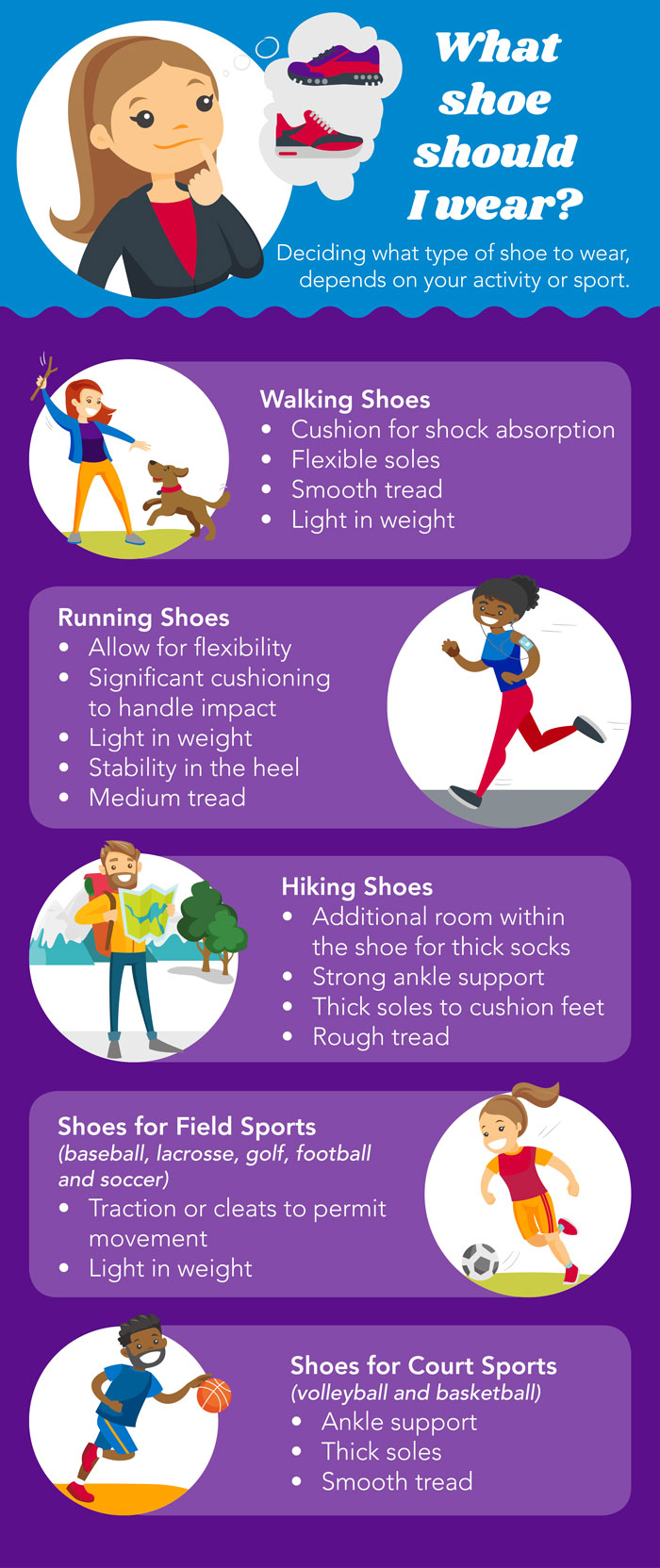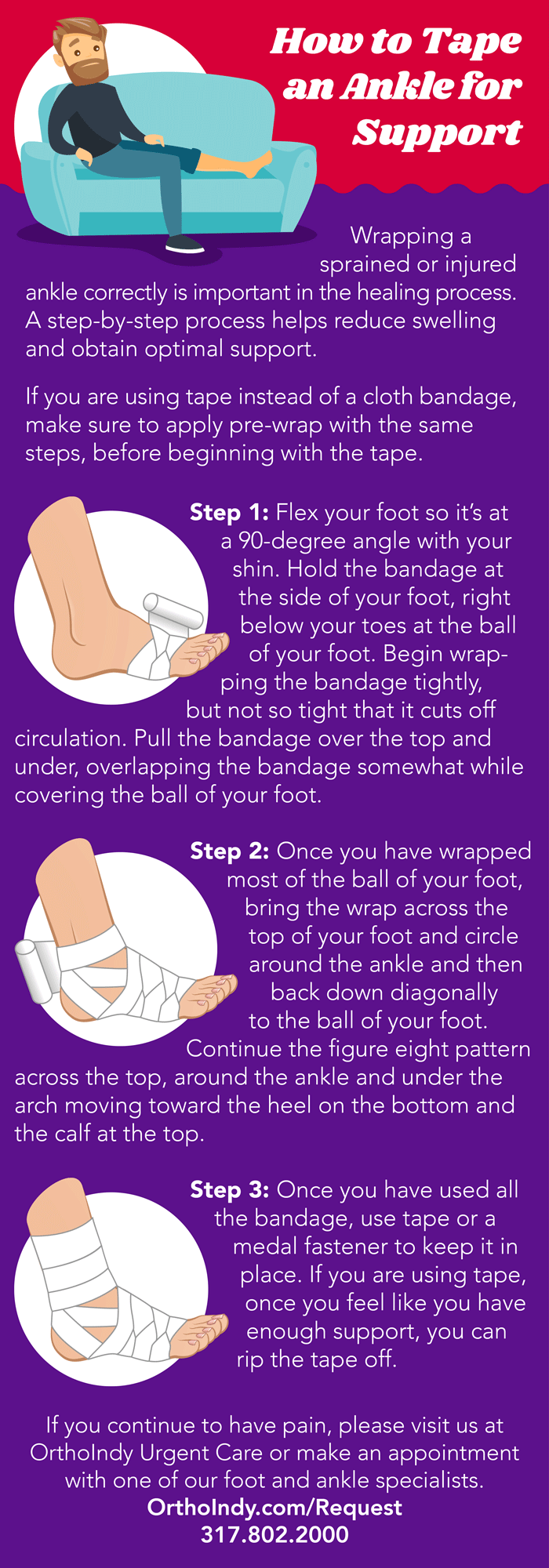The ultimate guide to
Foot and ankle injuries
This comprehensive guide will help you understand the causes of foot and ankle pain, injury prevention, how to treat an injury at home and when to seek care from a doctor

This guide discusses...
Relieve pain, recover quicker and prevent injury
The feet and ankles are one of the most used parts of the body and they hold a lot of weight on a daily basis. When a foot or ankle injury occurs, it can be difficult to get around, let alone perform your daily activities.
At OrthoIndy, our foot and ankle specialists work as a team to make sure your injury doesn’t hold you or your child back from your normal day-to-day commitments. From our urgent care clinics to our physical therapists, we focus on getting you back to work or your child back to sports.
Our Ultimate Guide to Foot and Ankle Injuries provides everything you need to know about injuries to the foot or ankle including when to seek treatment from a foot and ankle doctor, what to expect during treatment and how to prevent common foot and ankle injuries.
1 Common foot and ankle injuries and when to see a doctor
We generally use our feet and ankles anytime we are moving, especially during sports or exercise activity. So, it’s no wonder they are also prone to injury. Whether it’s due to overuse from repetitive motion, an acute injury such as a fall or a sports-related accident, injuries to the feet and ankles are common.
What are the most common causes of foot and ankle injuries?
- Overuse: Repetitive motion from a job or exercise activity
- Acute: A sudden injury from a trip and fall
- Sports: Injuries that occur from a fall or overuse and are related to a certain sport activity
When should I go to the doctor for a foot injury, ankle pain or a broken toe?
Even a seemingly minor foot or ankle injury can be painful and limit your daily activities. In some cases, pain will go away over time with at-home treatment, but other times it can be difficult to determine whether or not you should seek help from a doctor.
If you’re in significant pain or you’re unable to put any weight on your foot or ankle, you should visit an urgent care or emergency room right away.
Ignoring pain or trying to “tough it out” could make things worse. If pain or mobility issues are serious, the best thing you can do is seek treatment from a doctor to avoid making the injury worse and prolonging your treatment.
When should I be concerned about ankle pain or a foot injury?
It can be difficult to determine when to see a doctor for foot or ankle pain, especially if pain isn’t consistent such as with injuries like plantar fasciitis or heel pain. Additionally, ankle sprains can be just as painful as a broken ankle.
It’s not so much about the specific injury determining when you should seek treatment as it is about the amount of pain you are in and if you can put weight on it.
WATCH VIDEO: How to tell the difference between a sprained or broken ankle
Go to an urgent care or ER for foot or ankle pain if:
- You have severe pain and swelling
- You are unable to walk or put weight on your foot
- Have an open wound (Emergency room only)
- Have signs of infection such as redness, warmth or tenderness (Emergency room only)
Schedule an appointment with a foot or ankle doctor if:
- You have swelling that is persistent for two to five days even with at-home treatment
- Have persistent pain or occasional pain flare ups after activity for several weeks
- You are experiencing numbness or tingling in your foot
When should I go to the doctor for a broken toe?
Unless you have an open wound or significant deformity, a broken toe isn’t a reason to make a trip to an emergency room or urgent care. However, if you think you have a broken toe, it’s best to have a doctor look at it, even though you can treat it yourself at home. A broken toe can lead to more serious problems like infection, arthritis or long-term foot pain.
In most cases, you will be sent home with directions for at-home treatment such as icing, buddy taping and over-the-counter pain medications. Most times, a broken toe will heal in four to six weeks.
READ ARTICLE: When should I go to the doctor for a foot injury, ankle pain or a broken toe?

What is a foot and ankle doctor called?
There are many kinds of medical professionals that treat and evaluate conditions of the foot and ankle. Medical professionals that treat foot and ankle injuries include podiatrists, orthopedic surgeons, primary care physicians and physical therapists.
At OrthoIndy, we have foot and ankle orthopedic surgeons and physical therapists that focus on treating your foot and ankle pain with the most cutting-edge technology and treatment options.
What is the difference between a podiatrist and an orthopedic surgeon?
Podiatrists and orthopedic surgeons treat many of the same conditions related to the foot and ankle, but their training and scope of practice is different. An orthopedic foot and ankle surgeon will typically have the following education:
- Four years at an accredited medical school
- Five years of generalized orthopedic surgical residency training
- Additional fellowship training focusing on treatment of the foot and ankle
An orthopedic surgeon is a medical doctor who has a firm understanding of the entire musculoskeletal system. Additional training specific to foot and ankle diagnosis, treatment and rehabilitation help an orthopedic surgeon offer the best advice not only for the foot but also for the patient as a whole. At OrthoIndy, our foot and ankle specialists are fellowship trained in this specialty.
READ ARTICLE: What kind of doctor do you go to for foot and ankle pain?
 What are the most common foot and ankle injuries?
What are the most common foot and ankle injuries?
2 What to expect during treatment for a foot or ankle injury and how to treat your injury at home
How can I treat my foot or ankle injury at home?
If pain is bearable and there is not an obvious deformity, at home treatment such as rest, ice or bracing may help relieve pain and swelling.
R.I.C.E and pain medication
- Rest: Modify activities according to pain or minimize use
- Ice: Ice your foot or ankle intermittently during the first 24 to 48 hours by using a thin towel and applying ice for 20 minutes every two hours; never put ice directly on the skin
- Compression: Bandages or wraps can be used to reduce swelling and restrict movement; do not apply wrap too tightly
- Elevation: Raise your injured limb to an elevated and resting position above your heart
- Over-the-counter pain medication: Aspirin or ibuprofen can reduce swelling and pain; follow the instructions on the bottle
Rest or a change in activity
Common foot and ankle injuries are often a result of overuse and will go away with rest. Plantar fasciitis, heel pain or tendinitis are often your body’s way of saying it needs a break.
You should rest your injured body part or at least stop the activity that was causing you pain for two full weeks. Many active individuals rest for a day or two and stop feeling pain, so they think it’s okay to return to the activity. However, most times the pain will return immediately, and they are right back where they started.
For example, if running is causing you heel pain, stop running for at least two weeks. If you want to continue exercising, try cycling or swimming.
Stretching and strengthening exercises
Once the swelling and pain is lessened enough to resume movement, many overuse injuries can be treated with gentle stretching and strengthening exercises.
View our home exercise programs here
Ankle taping or bracing
If you are experiencing ankle pain or you have sprained your ankle, using an ACE wrap or an ankle brace will offer extra support. Using an ankle brace or wrap during activity can also help reduce the chance of injury or reinjury of the ankle as well.
Download our guide to at-home treatment for foot and ankle injuries

Learn how to treat your foot or ankle injury at home
Whether it’s a rolled ankle during a basketball game, sudden heel pain that seems to come out of nowhere or a broken toe, chances are you or your child will experience a foot or ankle injury at some point. We share tips on how to treat these frequent injuries at-home and when to seek professional care.
What to expect during treatment from a foot and ankle doctor
Treatment for a foot or ankle injury depends on the severity of the injury or pain, how long ago the injury occurred, your age and health, and your personal goals such as returning to work, sports or recreational activities.
For example, if you are experiencing ankle pain related to ankle arthritis, which gets in the way of your work, you may need to have surgery in order to lead a pain free life. However, if you have a sprained ankle, your doctor may recommend physical therapy or at-home treatment to relieve pain.
Your foot or ankle specialist will determine the best course of treatment for you.
An experienced foot and ankle specialist will start with nonsurgical treatment options such as:
- Physical therapy
- Injections
- Bracing
- Medication
- Shoe modifications
If these efforts are unsuccessful, then surgery may be suggested. A foot and ankle specialist should never jump right to surgery, and instead should focus on a plan you feel comfortable with and you both agree on.
3 What to expect during recovery from a foot or ankle injury
A foot and ankle injury can greatly impact your daily life no matter how seemingly small the injury may be. At times, it may feel like the pain will never go away, which can cause a lot of frustration.
Whether you had surgery or not, recovery after a foot or ankle injury takes time for the swelling to go down or the pain to go away. It’s important to follow certain steps to recovery and stay positive.
Recovery tips after a foot or ankle injury
- Reduce swelling: Ice your injury for up to 20 minutes several times throughout the day. Be sure to elevate your injured leg above your heart to reduce swelling whenever possible.
- Expect difficulty: It’s not easy to move around with a foot or ankle injury. Don’t be afraid to ask someone for help driving you places, getting dressed or doing your daily housekeeping tasks.
- Don’t resume normal activity too soon: Some foot or ankle conditions appear to go away so resuming normal activity before you have been given the go-ahead can seem tempting; however, during recovery it’s very easy to re-injure yourself or for pain to come back.
- Do foot and ankle strengthening exercises: Make sure to follow your doctor or physical therapists’ exercises for foot and ankle strengthening. Rehabilitation after a foot or ankle injury is important to reduce risk of re-injury and return to your normal active lifestyle.

Patient undergoes foot and ankle reconstructive surgery.
How soon can you return to normal activity after a foot and ankle injury?
Broken bones take six to eight weeks to heal but full recovery from an injury to the foot or ankle can take four to six months, and sometimes even longer. It depends on the severity of the injury and the treatment method.
READ ARTICLE: What to expect during recovery from a foot or ankle injury
How can physical therapy help your recovery process?
Exercise and movement are important following surgery. Muscle contractions through exercise release nitric oxide, which decreases inflammation, aids in wound healing and helps prevent stiffness.
OrthoIndy Physical Therapy has certified therapists that can assist you during your recovery process. A physical therapist will help you with exercises to regain movement and strength in your foot and ankle. They will also help you return to your daily activities and work tasks.

Busy mom brings son to OrthoIndy Urgent Care for broken ankle treatment.
4 How to avoid foot or ankle injuries
Foot and ankle injuries are common in work and sports activities, especially those that involve running, jumping and twisting such as basketball, tennis and soccer. However, even if you don’t consider yourself an athlete and you simply enjoy being active, it’s important to follow steps to prevent injuries in your foot or ankle.
6 tips for preventing foot or ankle injuries
- Warm up: Lightly stretch or go on a short jog to loosen up your muscles and get your body ready for activity.
- Start slow: Increase a new activity gradually over time. It takes time to build muscle strength and mobility.
- Be aware of uneven surfaces: Trips and falls are common causes of injuries to the foot or ankle during work or sports. Be careful on rocky terrain or loose gravel. Watch out for holes, uneven sidewalks or surfaces, and other trip hazards when hiking or running outdoors.
- Rest: Many foot and ankle injuries are caused by overuse. If you start to feel pain, stop the activity immediately and let your body heal before you resume. Ignoring the pain or “toughing it out” can make things a lot worse in the long run.
- Prevent recurrent injuries: If you have a history of ankle sprains, try wearing a brace during activity. If you have problems with heel pain, try shoe inserts. See a physician if pain persists.
- Choose the right shoe: Use sport specific shoes that fit your foot type. Cross training shoes are a good shoe if you participate in a variety of activities, but it’s best to use shoes designed specifically for the sport you are playing.
READ ARTICLE: How can foot or ankle injuries be prevented?
What about high-heels, flats, wedges and flip-flops?
It’s all relative and depends on the activity and the period of time you plan to wear those types of shoes. If you wear high-heels every day to work and you are on your feet quite a bit, you might start to develop foot and ankle pain related to metatarsalgia (pain under the ball of the foot), bunions or hammertoes.
However, if you listen to your body and stop wearing the heels when you’re in pain, you should be able to alleviate this.
The same goes for flip-flops or flats. If you are going to be doing a lot of walking or your job requires you to move fast, those types of shoes aren’t the best options because they don’t offer any support or cushion.

LEARN YOUR FOOT TYPE AND HOW TO FIND THE RIGHT SHOES FOR YOUR FEET
Whether you are going to the gym regularly, are an avid runner, are competing in sports or you’re simply walking around the office, shoes are important and play a role in your daily comfort level. Here we discuss what kind of shoes are best for your feet.
What should I look for when buying shoes?
- Shop for shoes after exercise or at the end of the day when your feet are at their largest.
- Try on shoes wearing the same type of sock or equipment you would normally wear with the shoe.
- Walk or even run a little bit in the shoe to make sure they are comfortable to move around in.
- If you are a woman with wide feet, some men’s shoes may fit you better as they are typically wider.
- If a shoe feels tight, sometimes a size up won’t help so always try the shoe on before making the purchase.
- Depending on your foot problems, ensure that the shoe addresses those needs. This could include a well cushioned heel if you suffer from heel pain or plantar fasciitis, soft upper materials in the toe box to avoid pressure on hammertoes.
- Most importantly, the best advice often is the shoe that is the most comfortable for you is the best shoe for you.

5 Is the cost of seeking treatment with a professional worth it?
When you know you have to have professional treatment for a foot or ankle injury, paying for these new medical expenses can be worrisome. First, it’s important to check with your insurance provider to ensure OrthoIndy is in your network. OrthoIndy and OrthoIndy Hospital participates in most major insurance networks.
Many insurance companies have pricing tools that take into account your benefit plan. Visit your insurance provider’s website to see if this is available to calculate surgery costs.
6 Foot and ankle resources
Foot and ankle treatment at OrthoIndy
OrthoIndy specialists focus on treating your foot or ankle injuries with the best options to keep you active in your daily activities. Whether it’s work, sports or recreational activities we want you to get your normal back.
Meet the doctors
Request an appointment
Downloadable guides
- The Ultimate Guide to Foot and Ankle Injuries
- At-home treatment for foot and ankle injuries
- Understanding your feet and what shoes to wear
Blog articles
- When should I go to the doctor for a foot injury, ankle pain or a broken toe?
- What kind of doctor do you go to for foot and ankle pain?
- What to expect during recovery from a foot or ankle injury
- How can foot or ankle injuries be prevented?





